Rapamycin: Anti-aging and metabolic dream drug?
-
Hey! Great points.
It's interesting that you came to the same conclusions as I have.
-
Selenium can partially replicate MR benefits. Especially sodium selenite.
-
A certain part of MRs benefits are due to inhibition of mTOR, although not all.
This is where rapamycin comes into play.
So far I haven't found anything that completely substitutes for going on a low protein diet.
- A low protein diet should be very helpful against cancer.
And that is why Koch's "vegan" diet worked, because it was low protein. He was so much ahead of his time .
None of the 40% life span increase studies or anti-cancer studies on MR had been done during his life time. Yet he figured it out.
And let's not forget that he figured out that quinones are good for cancer as well. Legend.
That makes me wonder how quinones affect protein restriction, methionine or mTOR. Maybe there's a connection, too.For all of these points I posted studies in this thread:
-
-
Surprisingly this review argued that quinones would increase mTOR.
Because quinones increase Nrf2 which in turn increases mTOR.What should we think of that ?
In theory that would cause a pro-cancer effect, but quinones do lot more than activating Nrf2 ... -
This is the type of study I want to see.
The combination of rapamycin and methioniase eradicated osteosarcoma.
The interesting part is that rapamycin or methioniase alone were not able to do that.
You can see on the chart that rapamycin was somewhat effective at slowing tumor growth, but it still grew.When rapa and methioniase were combined the tumor didn't even start to grow, it even decreased in size.
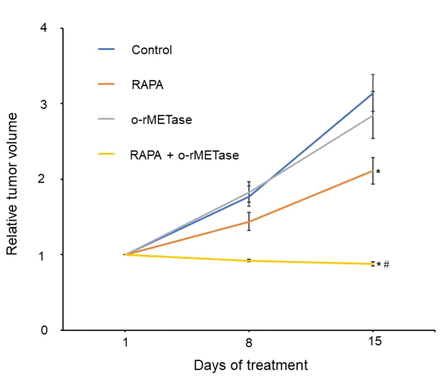
The implication here is that a low methionine diet and rapamycin are syngergistic.
We can replace methioniase with a low protein diet, since they both have the same outcome.Obviously this is relevant for cancer patients, but since cancer is just a deranged metabolism this is relevant to all other issues of metabolism. Meaning even if you're on a low protein diet you might benefit from rapamycin and even if you're on rapamycin, you might still benefit from a low protein diet.
@evan-hinkle i think you tried both, did you notice any commonalities or added benefits between rapa and MR ?
-
@Mauritio great thanks , an idea of why they synergise maybe ,
https://pubmed.ncbi.nlm.nih.gov/27153561/
^ here a carbonic anhydrase inhibitor helped rapamycin become more effective due to decreasing the hypoxic areas giving the mtor inhibition a bigger area to have effect in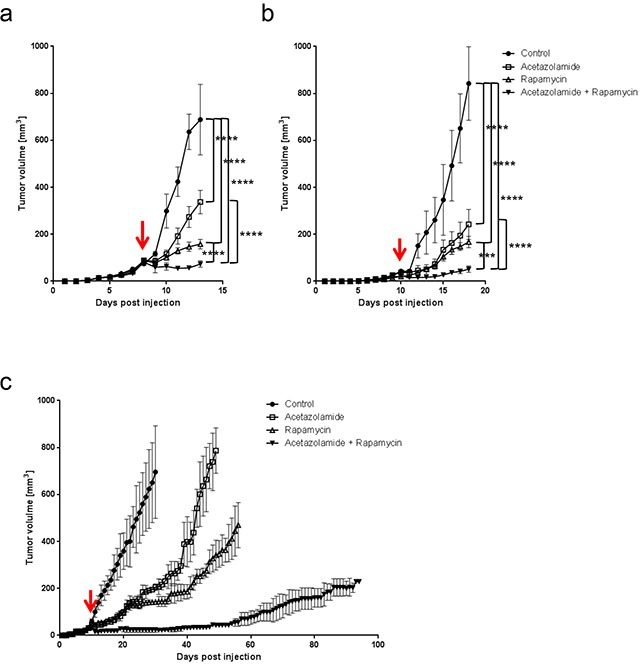
maybe the methionine restriction helps decrease the hypoxia enabling the mtor inhibition from rapamycin to have broader effect in the tumors (and shows high dose thiamine should also be synergistic with rapamycin)
(thiaminase which depletes cell of thiamine can inhibit tumors & interestingly rapamycin reverses the effect. but on the other side as we know thru haidut studies dosing high enough thiamine inhibits carbonic anhydrase and has a major impact on inhibiting tumors so probably could mimic that synergy as extra) -
@cs3000 that is interesting. If acetazolamide can more or less substitute for MR in this scenario then that probably means MR's benefits in terms of cancer rely on CO2 increase as almost everything acetazolamide does is downstream from an increase in CO2.
On the other hand tumors have something called "methionine addiction" also called the Hoffman effect, so that might play a role as well.
"This phenomenon describes the inability of cancer cells to proliferate when methionine is replaced with its metabolic precursor, homocysteine, while proliferation of non-tumor cells is unaffected by these conditions. "
https://www.ncbi.nlm.nih.gov/pmc/articles/PMC7226524/ -
@Mauritio some extra mechanisms to boost things further then, the 3 together look like a nice combo for helping to sort tumors
Methionine restriction alone increased tumor growth & animal death in intestinal cancer here
(because of sulfur depletion effect on lowering immunity, they note it only helps when you start it at tumor initiation instead of starting MR a few weeks before because by 3-4 weeks anti tumor immunity is skewed).edit: doesnt explain why the MR didnt work alone in the combo study as they started 3 weeks after initiation
https://www.nature.com/articles/s42255-023-00854-3#Sec2
but yeah the combo worked so thats the key nice insight ty -
@cs3000 yeah. And combining acetazolamide with CO2 baths might make the combo even more effective. I remember the impressive studies you posted on CO2 baths for cancer where the tumor shrunk significantly. Adding acetazolamide should help you retain the added CO2 longer.
-
@Mauritio your post and the next from @cs3000 are incredibly synchronistic because I am currently experimenting with both low protein and high dose thiamine. I have not used Rapa in a while, (I was having diminishing effects as time went on-though I think thiamine deficiency was an issue there-or perhaps more correctly stated: my current use of thiamine seems to be addressing the rate limiting effects I get from any pro-metabolic substance).
On Rapa I noticed stronger teeth, smoother teeth, healthier gums, faster nail growth, and better skin quality, (but after a while it lead to constipation, skin issues, teeth sensitivity, etc). Protein restriction was the exact same, better in all typical symptoms, and then worsening. Dextrose was similar, (same pattern). But, using thiamine in 1 gram doses twice a day has been different. No constipation, better skin, nail growth, improved oral health, mental clarity, verbal fluency, (all the signs I get from a pro-metabolic substance).
The very exciting part is that thiamine is allowing me to stack modalities now for healing, (or at least keeping all symptoms of low metabolism at bay). Previously if I used red light with say thyroid or high sugar, I would have a stress reaction, now, thiamine is letting me eat more, (or take dextrose in greater quantities) and then get positive effects from red light. It’s like previously anything that increased energy production would hit a roadblock, but now thiamine is simply letting me increase energy production and fuel consumption to compensate. I would be very interested to see what stacking Rapa here could do potentially.
-
@evan-hinkle congrats on the success with b1.
Such a shame that rapa stopped working.
I'll try it soon too. -
If one wants to replace rapamycin haiduts lipodd might be a good alternative.
This study compared C15 to rapamycin and other compounds and found the biggest overlap on terms of anti-aging activity between C15 and rapamycin. C15 also inhibits mTOR.
"At their optimal doses, C15:0 shared numerous clinically relevant activities with rapamycin and metformin."
https://www.mdpi.com/2072-6643/15/21/4607What's interesting as well is it's ability to be incorporated into cell membranes . Theres a clear tendency amongst animals: the more saturated the cell membranes, the longer the animals live.
(Book recommendation on this topic: Human longevity by Valentine and Valentine)
-
@Mauritio just to tack on here, my wife and I could not get Lipodd out of the bottle if our life depended on it. It either came out in a jet stream negating the possibility of dosing, or not at all, (to be fair, it could have just been our bottle, but we haven’t tried it again, and unfortunately gave up on it). We did try warming the bottle in some warm water to see if it helped, but no luck.
-
@Mauritio said in Rapamycin: Anti-aging and metabolic dream drug?:
When rapa and methioniase were combined the tumor didn't even start to grow, it even decreased in size.
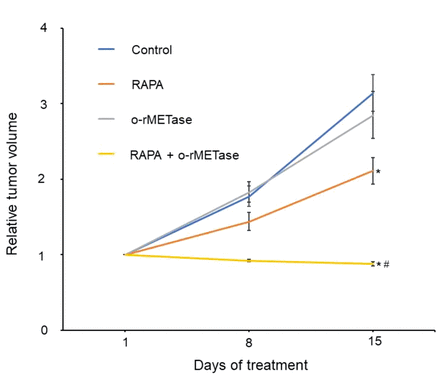
The implication here is that a low methionine diet and rapamycin are syngergistic.
This is a very interesting combination. For now, I am avoiding pharmaceutical drugs like rapamycin. Having said that, here is another rapamycin study that might be of interest.
A combination of the geroprotectors trametinib and rapamycin is more effective
than either drug alone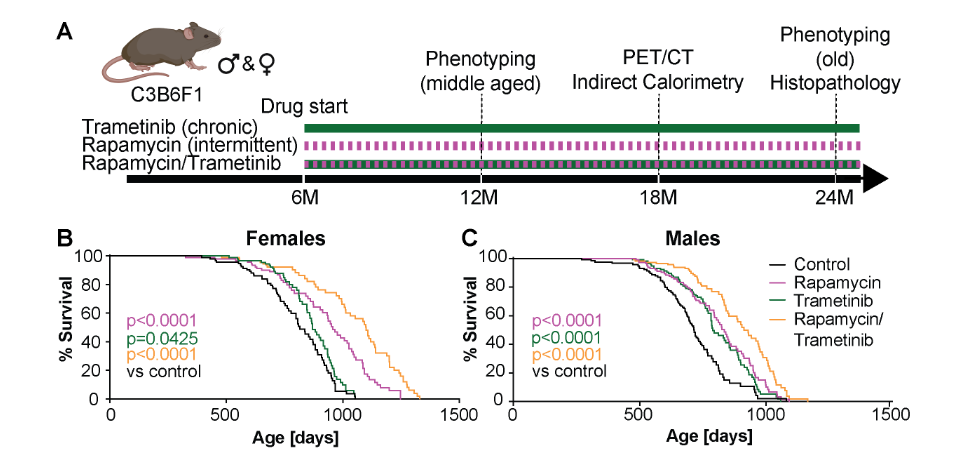
-
Iron: an underrated factor in aging
Abstract
Iron is an essential element for virtually all living organisms, but its reactivity also makes it potentially harmful. Iron accumulates with aging, and is associated with many age-related diseases; it also shortens the lifespans of several model organisms. Blocking iron absorption through drugs or natural products extends lifespan. Many life-extending interventions, such as rapamycin, calorie restriction, and old plasma dilution can be explained by the effects they have on iron absorption, excretion, and metabolism. Control of body iron stores so that they remain in a low normal range may be an important, lifespan- and healthspan-extending intervention.
The pdf has hotlinks to 76 references and it identifies them in part using their titles so that they are easy to find.
-
@DavidPS Thanks for sharing that combination study !
Around a 30% increase in life span. Not bad.
This study shows that stacking anti-aging substances (with different mechanisms) lead to an additive effect in life extension. The authors also cite more studies where that was the case in the "discussion" section.In this study:
mTOR is covered by rapamycin.
The ERK pathway by trametinib.Now I'm wondering what would happen if you combine selegiline or ergothioneine with rapamycin since they both have different MoA than rapamycin,targeting oxidative stress mainly.
-
@Mauritio said in Rapamycin: Anti-aging and metabolic dream drug?:
ergothioneine
is taking histidine to increase ergothioneine a good option ? i also have alanine to help generate carnosine (or is histidine rarely a rate limting source)
-
@Mauritio said in Rapamycin: Anti-aging and metabolic dream drug?:
Now I'm wondering what would happen if you combine selegiline or ergothioneine with rapamycin since they both have different MoA than rapamycin, targeting oxidative stress mainly.
Selegiline is another drug that I want to avoid. It has complex influences in the body. I am willing to wait. Vitamin E is surprisingly good for longevity in male mice.
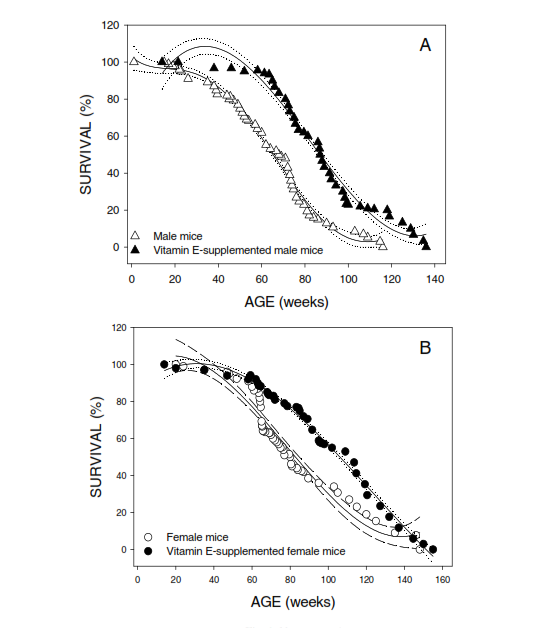
I do not know if it would be additive with rapamycin.

-
@DavidPS wow, 40% increase in median life span in male mice is pretty good!
There must be something that benefits male mice more than female mice about vitamin E.It might be that vitamin E could at least partially substitute for selegiline. Since they're both ameliorating oxidative stress. I think there's a lot to the free radical theory of aging otherwise substances like selegiline, ergothioneine or vitamin E wouldn't be so successful in retarding death.
The oxidative stress is mostly downstream from PUFA consumption IMO, that's Why peat said there would be little use for vitamin E, if PUFA consumption was low or zero.
The above book recommendation comes to mind again.Vitamin E seems to rescue the sickest individual, hence the increase in median life span, but has less drastic effect on maximum life span. In other words it prevents premature death first and foremost.
Which is similar to what selegiline is doing.
I talked about this on the forbidden forum in this post Post in thread 'Selegiline Experiences' https://raypeatforum.com/community/threads/selegiline-experiences.18419/post-903080Btw selegiline has good safety record and has been used in humans for decades. So I don't see any issues with weekly dosing.
-
Another thing about that study is that they used vitamin E acetate.
There have been several studies showing vitamin E acetate as less effective or even harmful compared to vitamin E succinate.In this case the succinate form decreases liver carcinoma by 77% and acetate actually increased it.
https://raypeatforum.com/community/threads/vitamin-e-succinate-very-effective-against-liver-carcinoma-acetate-form-increases-it.35475/Another case: 650% lower tumor volume with vitamin E succinate and no result from acetate.
https://raypeatforum.com/community/threads/vitamin-e-succinate-decreases-melanoma-size-by-650-in-vivo.39088/So I'm wondering how effective Vitamin E succinate would have been for life extension?!
(BTW can someone tell these people that I'm banned on the RPF
 I still see people asking me questions in several threads)
I still see people asking me questions in several threads) -
hey bud, which type of thiamine are you taking?
I had very similar benefits from B1 too (TTFD version), though they seem to have diminished (not sure if it's to do with low glutathione status etc. - https://hormonesmatter.com/paradoxical-reactions-with-ttfd-the-glutathione-connection/#:~:text=The initial phase of processing,use up” their reduced glutathione.)
I tried a B1 version which contained several different types (i.e. hcl, TTFD, Benfo), again had some great results, notably very energetic and somewhat of a pro-dopamine "state", though this diminished too after a day.
-
@Ismail hey man, just using regular old thiamine hcl. I’ve tried others, and they seem to work as well, but I just have to take a little more of the hcl version to get the same results.